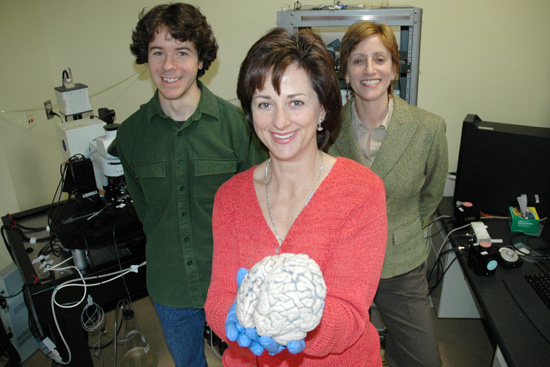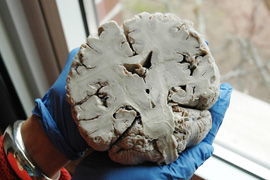Grant to Fund Epileptic Seizure Study at Wesleyan
 |
| Gloster Aaron, Janice Naegele and Laura Grabel will study if stem cell-based treatment in mice brains could possibly control epileptic seizures in human brains. |
| Posted 12/04/06 |
| A $300,000 grant from the McKnight Foundation will help a Wesleyan University researcher investigate the possibility of using brain transplants of embryonic stem (ES) cells to control epileptic seizures in mice. If successful the study could lay the early groundwork for using similar therapy in human beings.
Janice Naegele, chair and professor of biology and professor of neuroscience and behavior at Wesleyan, is the principle investigator in the study that will bring together the expertise two other Wesleyan faculty Laura Grabel, Fisk Professor of Natural Science, professor of biology, and Gloster Aaron, assistant professor of biology as well as Gordon Fishell, professor of biology at New York University. During the three-year study, Naegele and her colleagues will attempt to create GABAergic neurons from mouse ES cells and implant them in the brains of mice that experience epileptic seizures. The hope is that the new neurons derived from the grafted ES cells will be able to restore normal levels of the brains inhibitory neurotransmitter GABA by replacing GABAergic neurons destroyed by the epileptic seizures. GABA is one of the key chemical messengers in the brain that regulates the firing of neurons and prevents seizures. A lot of the focus in stem cell-based treatment is in treating neurodegenerative disorders, Naegele says. Due to ethical roadblocks in harvesting neural stem cells from human embryos, a preferred course is autologous donation taking an individuals own stem cells and using them to generate neural stem cells for treatment. However, in the case of some forms of inherited epilepsy, there a genetic defect in the neurons that causes the seizures. This defect is likely mirrored in the patients stem cells, which is one reason why we are focusing on using non-autologous cell lines. From a clinical perspective, animal epilepsy isnt identical in all facets to human epilepsy. However, it is close enough that Naegeles successful use of these GABAergic neurons to control seizures will go a long way to help scientists understand the potential treatment implications in humans. For the study, the researchers will chemically induce the initial epileptic seizures in the mice. After two to three weeks, the mice develop spontaneous seizures, making the overall effect more similar to the way seizures occur in humans. The stem cell grafts will be made into the brains of transgenic mice that have fluorescent neurons, allowing the scientists to identify interactions between the cells in the grafts and the host brains using a combination of electrical recording and microscopic imaging. The studies will attempt to demonstrate that the grafted stem cells form connections with the host brain, a critical step for functional recovery from epilepsy. To create the cells needed to potentially suppress the seizures, Naegeles team will use a new method to produce high yield GABAergic neurons.
Along with the faculty mentioned, this three-year study will also involve post-doctoral students, graduate, and undergraduate students at Wesleyan who will be assisting with components of the research. This is really exciting because it is bringing together three labs here and a lab down at NYU, Naegele says. The expertise at each complements the others. Its a more risky study than others in this area, but the potential information we can generate will really be useful as we move forward investigating if this can be an effective treatment for epileptic seizures. In addition to supporting this collaboration, Naegele will participate in a yearly McKnight Conference on Neuroscience, which fosters interactions among the awardees of all of their programs. This years conference will be held in the June 2007 in Aspen, Colorado and will focus on music, art, and the brain. According to their Web site, The McKnight Endowment Fund for Neuroscience is an independent charitable organization established by The McKnight Foundation to carry out the wishes of its founder, William L. McKnight (1887-1979), who led the 3M company for three decades. McKnight had a personal interest in memory and its diseases. He chose to set aside part of his legacy to bring hope to those suffering from brain injury or disease and cognitive impairment. The Neuroscience of Brain Disorders Awards were established in 2000 as the Memory and Brain Disorders Awards. Each year, up to six awards are given. Awards provide $100,000 per year for three years. For more information go to www.mcknight.org/neuroscience. |
| By David Pesci, director of Media Relations. Photo by Olivia Drake, The Wesleyan Connection editor |


 We plan to use molecular-genetic approaches to get the neural stem cells to express a sequence of transcription factors that will regulate the genes required to produce the GABAergic neurons, Naegele says. They will then be transplanted to the mouse hippocampus and then well see if they have enough genetic information to act properly.
We plan to use molecular-genetic approaches to get the neural stem cells to express a sequence of transcription factors that will regulate the genes required to produce the GABAergic neurons, Naegele says. They will then be transplanted to the mouse hippocampus and then well see if they have enough genetic information to act properly.